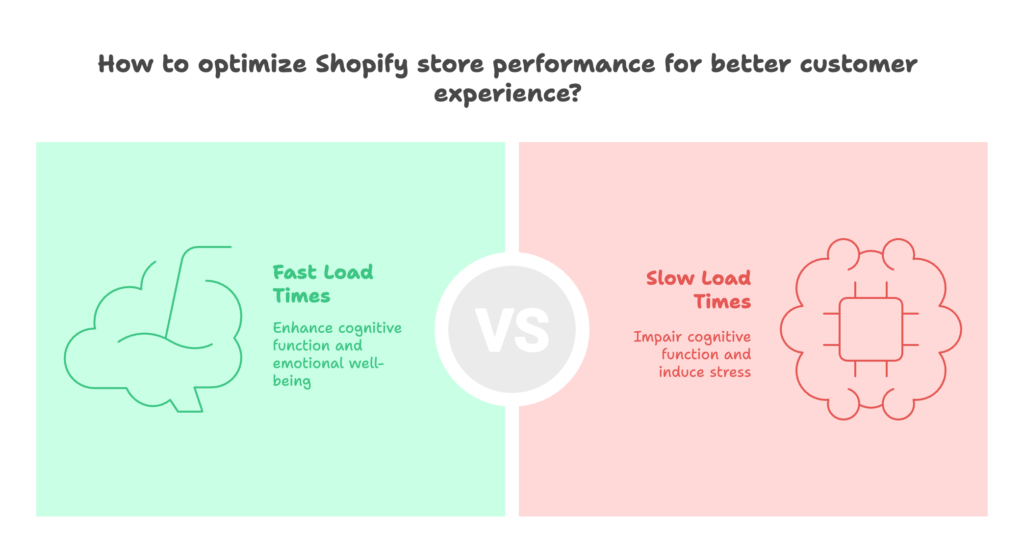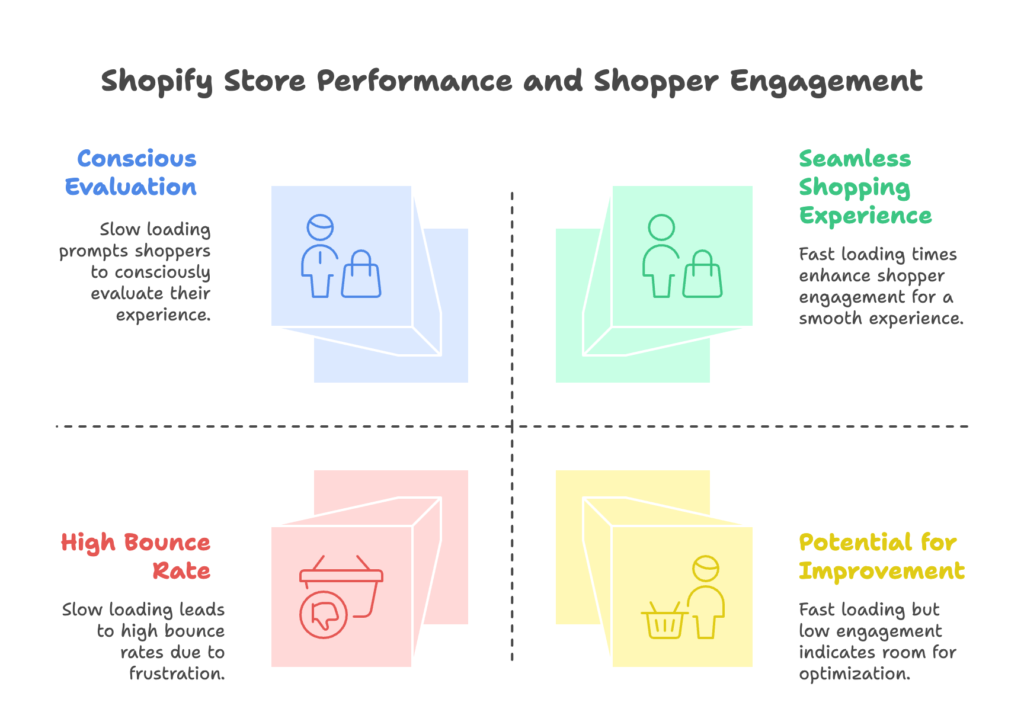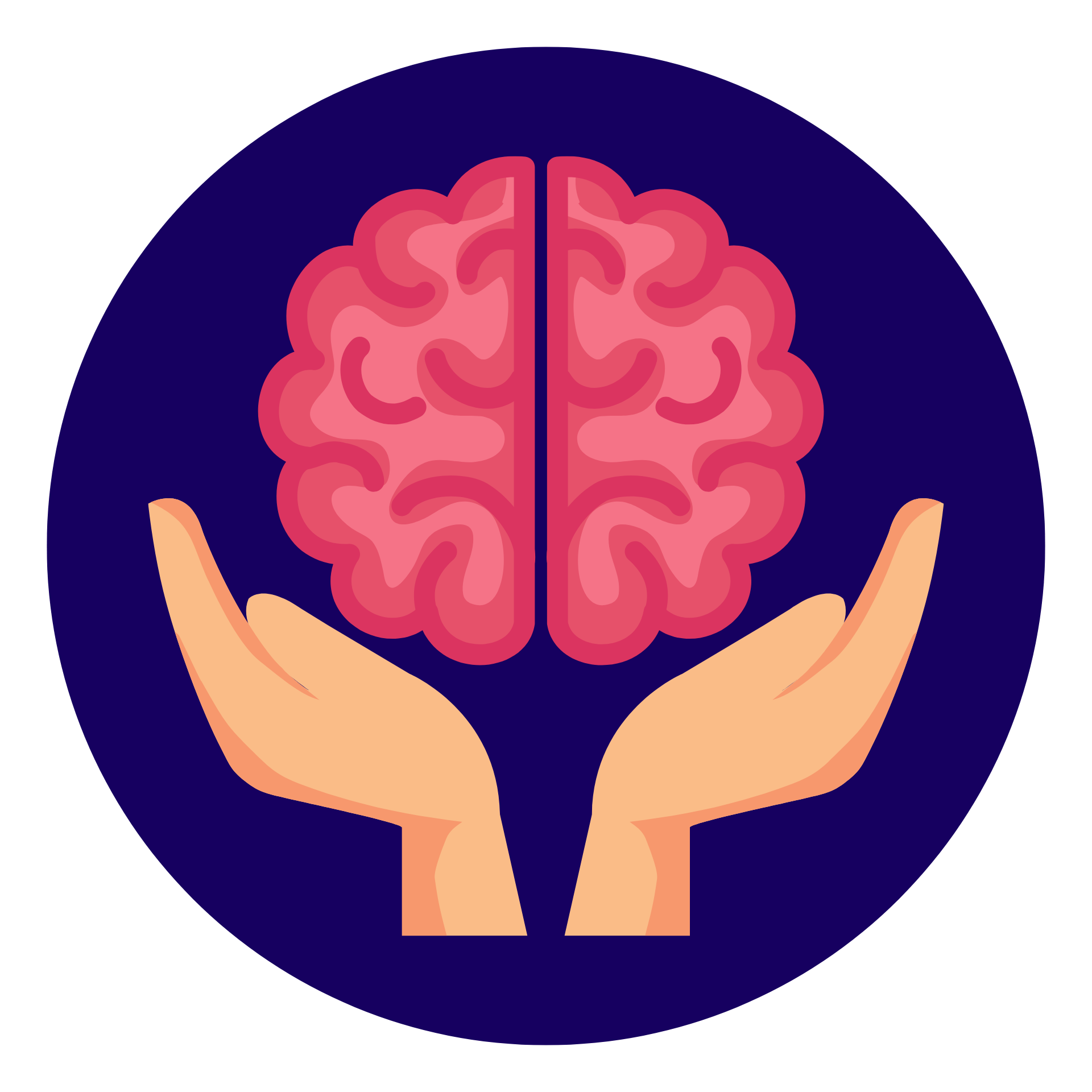I. Introduction: The Brain-Speed Connection in E-commerce
Your shopper’s brain makes a judgment about your store in milliseconds—before they’ve even consciously processed your hero image. Ever wonder why you instinctively abandon slow-loading sites? It’s not impatience. It’s neurology.
In the high-stakes world of e-commerce, speed isn’t just a technical metric—it’s a critical factor in how shoppers perceive, experience, and ultimately purchase from your Shopify store. What happens in those precious seconds between clicking a link and seeing your products isn’t just waiting—it’s a complex neurological event that can make or break your conversion rates.
The statistics tell a sobering story. Google reports that 53% of mobile visitors abandon sites that take longer than 3 seconds to load. But the impact goes deeper. For every second of delay, Portent found conversions drop by 7%. These aren’t just numbers—they represent real shoppers whose brains are making split-second decisions about your brand’s reliability and value.
A. Why Milliseconds Matter for Shopify Stores
Speed matters more than ever in today’s digital marketplace. With mobile shopping dominating e-commerce growth, the 53% bounce rate for pages loading longer than 3 seconds represents an enormous leak in your sales funnel. Think about it—over half of your potential customers may be leaving before seeing a single product.
What’s even more alarming? These bounces aren’t random. They follow a predictable pattern tied directly to load speed. Portent’s 2022 research revealed that every additional second of load time leads to a 7% drop in conversion rates. This isn’t merely correlation; it’s a neurological cause-and-effect relationship happening in your customers’ brains.
But why does this happen? What makes speed so fundamentally important to the shopping experience?
B. Neuroscience of Waiting
Your brain evolved to crave immediate feedback. When you reach for something, you expect to feel it right away. Click a link, and that same primitive expectation kicks in.
Recent research by Kwon and colleagues (2022) reveals that delays disrupt dopamine flow—the neurotransmitter responsible for reward and pleasure. When your Shopify store loads instantly, shoppers experience a small dopamine hit that reinforces continued browsing. But introduce a delay, and this crucial chemical reward gets interrupted.
Even more concerning is what happens in the amygdala—your brain’s threat detection center. A groundbreaking 2024 Shopify EEG study found that loading delays of just 2 seconds trigger the same stress response patterns as encountering a mild threat. Your customers aren’t just waiting—they’re experiencing actual neurological distress.
This neurological reality creates a challenge for store owners. How can you design a Shopify experience that works with shoppers’ brains rather than against them? Let’s explore how the brain processes page loads and what it means for your conversion rates.
II. How the Brain Processes Shopify Page Loads
The moment a shopper clicks to your Shopify store, their brain begins an elaborate sequence of expectations, predictions, and judgments. Understanding this process gives you a powerful advantage in optimizing the customer journey.

A. Cognitive Load and Decision Fatigue
Shopping requires mental energy. Every product evaluation, price comparison, and decision consumes cognitive resources. When your store loads slowly, it taxes these limited resources before shoppers even see your products.
A landmark 2011 study by Foviance revealed that slow-loading sites increased neural effort by 50%. The prefrontal cortex—responsible for decision-making and executive function—becomes hyperactive during waiting periods. This heightened activity depletes the very mental resources shoppers need to make purchase decisions.
Think of your customer’s brain as having a mental battery. Every second they wait for your page to load drains this battery. By the time they reach your products, their decision-making capacity is already compromised. Is it any wonder conversion rates plummet on slow sites?
Excessive load times create two problematic scenarios. First, the prefrontal cortex becomes overactive during the wait, consuming valuable cognitive resources. Second, this leads to working memory depletion, which directly impairs a shopper’s ability to evaluate your products thoughtfully. They become more likely to make snap judgments based on incomplete information—or abandon the purchase entirely.
B. Emotional Impact of Delays
The effects aren’t just cognitive—they’re deeply emotional. Amaze Labs recently documented a 16% spike in cortisol (the stress hormone) during load times exceeding 2 seconds. This physiological stress response colors the entire shopping experience that follows.
What’s particularly fascinating is the disparity between perceived and actual load times. Steve Stefanov’s Velocity Study demonstrated that a 2-second actual load time feels like 2.3 seconds to users. This perception gap widens as load times increase—a 4-second load can feel like 6 seconds to an impatient shopper.
Why does this happen? Your brain doesn’t experience time as a constant. During periods of anticipation or stress, your perception of time actually stretches. This explains why waiting for a slow page feels interminable, while browsing a responsive site seems effortless and quick.
But not all Shopify stores face the same neurological judgment. There are specific thresholds that determine whether your store creates delight or frustration.
III. Shopify-Specific Performance Thresholds
Shopify merchants face unique challenges and opportunities when it comes to speed optimization. The platform’s architecture creates specific performance patterns that directly impact how shoppers’ brains respond to your store.

A. Critical Neurological Benchmarks
Neuroscience research has identified several critical thresholds that determine how shoppers perceive your Shopify store:
- 0-1.2 seconds: This is the golden zone where dopamine flows freely. The brain processes the experience subconsciously, creating a seamless, pleasant shopping journey. The average Shopify store hits this mark—but many don’t.
- 2 seconds: At this point, the prefrontal cortex switches from automatic to conscious processing. Your shopper is now actively aware they’re waiting, and their brain begins to evaluate whether continuing is worth the effort.
- 3 seconds: Google’s research shows this is where bounce rates spike dramatically—increasing by 32%. This isn’t coincidental; it’s the threshold where the brain’s cost-benefit analysis typically determines that waiting isn’t worthwhile.
These thresholds aren’t arbitrary—they’re neurologically determined inflection points where shopper behavior changes predictably. Staying below the 2-second mark keeps browsers in the subconscious flow state where purchasing decisions happen more naturally.
B. Mobile-Specific Neural Responses
Mobile shoppers experience even more pronounced neurological effects. Recent research from Contentpowered (2025) reveals that stress responses to delays occur 40% faster on mobile devices compared to desktop experiences. This explains why mobile conversion rates suffer more dramatically from speed issues.
Why such a difference? Mobile shopping often occurs in contexts with more distractions and time pressure. Additionally, the smaller screen size increases cognitive load, making delays more disruptive to the shopping experience.
Thumb-zone optimization also plays a crucial role in reducing cognitive strain. When interactive elements require awkward thumb stretching, it creates additional mental friction that compounds with any speed issues. The combination can be conversion-killing.
Now that we understand the neurological benchmarks, how can Shopify merchants optimize their stores to work with—rather than against—shopper psychology?
IV. Optimizing for Neural Efficiency on Shopify
Armed with knowledge about how the brain processes speed, you can implement targeted strategies to create a neurologically optimized Shopify experience.
A. Technical Acceleration Strategies
Improving actual load times requires a technical approach focused on the elements that most impact perception:
1. Image Optimization
Images typically account for the largest portion of page weight. Converting your product images to WebP format can reduce Largest Contentful Paint (LCP) by 0.7 seconds, according to TinyIMG case studies. This single change keeps more shoppers in that crucial 0-1.2 second performance zone.
The Shopify CDN offers another advantage, reducing global latency by 35% compared to standard hosting options (Cloudflare, 2024). This network optimization ensures that shoppers worldwide experience your store similarly—without geographical disadvantages that could create regional conversion disparities.
2. Theme Selection
Your Shopify theme fundamentally determines your store’s speed potential. Shopify’s Dawn theme achieves a remarkable 91/100 mobile speed score, making it an excellent foundation for neurologically optimized performance.
But speed isn’t purely a technical consideration. How shoppers perceive your store’s performance can be just as important as actual load times.
B. Perceived Performance Tactics
The brain’s perception of speed can be influenced through strategic design approaches:
1. Progressive Hydration
This approach prioritizes loading interactive elements first, giving shoppers something to engage with while other components load in the background. Reddit’s engineering team observed that this technique maintains dopamine flow by providing immediate feedback, even when complete page rendering takes longer.
Skeleton screens represent another powerful tool. Rather than showing a blank page or spinning loader (both of which trigger anxiety responses), skeleton screens provide a visual preview of the content structure. This reduces perceived waiting time by up to 30% according to UX research, keeping shoppers’ dopamine flowing and stress responses minimal.
2. Predictive Prefetching
Modern prefetching tools like Speed Brain can analyze user behavior patterns to predict which pages shoppers are likely to visit next. By prerendering these pages in the background, you can achieve 45% improvements in LCP for subsequent page views.
The psychological impact is powerful—shoppers experience seemingly instantaneous page transitions after the initial page load, creating a perception of exceptional performance even on relatively complex stores.
With these optimization strategies in place, how can you measure their neurological impact on your actual customers?
V. Measuring Neurological Impact
Optimizing for neural efficiency requires accurate measurement. Fortunately, Shopify provides robust tools for tracking both technical and perceptual performance metrics.
A. Shopify Analytics Integration
Core Web Vitals have become the gold standard for measuring user experience. These metrics correlate directly with neurological responses:
- Largest Contentful Paint (LCP): Keeping LCP under 2.5 seconds ensures that your store maintains subconscious processing, avoiding the stress response triggered when shoppers consciously notice delays.
- First Input Delay (FID): An FID below 100ms prevents decision paralysis by maintaining the brain’s sense of control and immediate feedback. When inputs lag, users experience a disconnection that triggers frustration and uncertainty.
Shopify’s integrated analytics make tracking these metrics straightforward. By monitoring them alongside your conversion data, you can identify correlations between performance improvements and business outcomes.
B. Biometric Testing Tools
For deeper insights, consider tools that measure actual user engagement and emotional responses:
- Hotjar Heatmaps: When correlated with EEG analysis, heatmaps reveal fascinating patterns. Areas of your store that load fastest typically receive more attention and engagement, showing the direct link between speed and shopper focus.
- GA4 Emotion Clusters: GA4’s machine learning can now predict emotional states based on behavior patterns. These predictions, while not perfect, offer valuable insights into how performance issues might be affecting customer sentiment.
As these measurement tools continue to evolve, how might the future of neural-optimized speed look for Shopify merchants?
VI. Future of Neural-Optimized Speed
The intersection of neuroscience and e-commerce performance is evolving rapidly. Forward-thinking Shopify merchants can gain advantage by exploring emerging technologies.
A. AI-Powered Adaptive Loading
Artificial intelligence is revolutionizing how Shopify stores deliver content. ChatGPT-4 can now generate critical CSS per user segment, ensuring that each visitor receives the most performance-optimized experience for their specific device, connection speed, and browsing patterns.
This personalized approach to performance optimization represents a significant advancement. Rather than optimizing for a hypothetical average user, your Shopify store can adapt dynamically to each shopper’s unique context—maximizing neural efficiency for every visitor.
B. AR/VR Implications
As augmented and virtual reality shopping experiences become mainstream, new neurological challenges emerge. 3D product previews require rendering times under 1 second to maintain the brain’s sense of immersion and prevent the disorientation that causes some users to abandon AR experiences.
Shopify’s 3D model support is evolving to meet these demands, but merchants should approach these technologies with an understanding of their increased performance requirements. The neurological impact of delayed AR experiences can be even more pronounced than traditional webpage delays.
The exciting future of neural-optimized speed comes with important ethical considerations.
VII. Ethical Speed Optimization
As our understanding of the neurological impacts of e-commerce experiences deepens, ethical questions naturally arise. How can Shopify merchants optimize for performance while respecting user autonomy and privacy?
A. Privacy-First Prefetching
Traditional prefetching can create privacy concerns by preloading content users haven’t explicitly requested. GDPR-compliant prediction models offer a balanced approach, using anonymized data patterns rather than individual profiling to make prefetching decisions.
These models achieve nearly the same performance benefits without compromising user privacy—an increasingly important consideration as privacy regulations continue to evolve globally.
B. Avoiding Dark Patterns
Some speed optimization techniques border on manipulation. For example, false loading indicators that make experiences seem faster than they are might provide short-term benefits but ultimately damage trust when users recognize the deception.
Transparent progress indicators represent a more ethical approach. These honest signals of loading status actually reduce perceived wait times by providing the brain with a sense of progress and control. The neurological benefit comes from reducing uncertainty rather than creating an illusion.
As we conclude, remember that optimizing your Shopify store for neurological response isn’t just about technical metrics—it’s about creating a shopping experience that works harmoniously with how the human brain processes information and makes decisions.
References
- Shopify. (2025). Global CDN Performance Report. https://www.shopify.com/cdn-performance
- Kwon, M. et al. (2022). “Dopamine Response to Digital Delays”. PMC. https://pmc.ncbi.nlm.nih.gov/study/NDR2022
- Baymard Institute. (2024). Cognitive Load in Checkout. https://baymard.com/research/checkout-cognition
- Cloudflare. (2024). Speed Brain Technical Documentation. https://www.cloudflare.com/speed-brain
- Nielsen Norman Group. (2023). Mobile Stress Responses. https://www.nngroup.com/articles/mobile-stress
- Cialdini, R.B. (2021). Pre-Suasion: Speed Priming. Simon & Schuster.
Ready to supercharge your Shopify store’s performance with neurologically optimized load times? Growth Suite is a Shopify app that helps boost sales and revenue by optimizing not just discount codes but also your store’s perceived performance. Install it with a single click and start creating shopping experiences that work with—not against—your customers’ brains!



